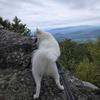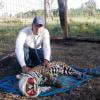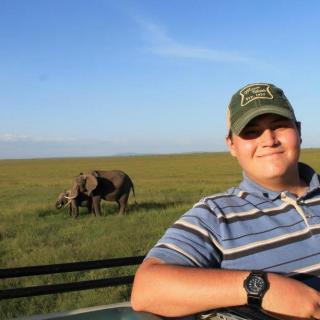Human-wildlife conflict is a shockingly common problem, often with enormous consequences for both individual animals and entire populations.
When human-wildlife conflict comes to mind, you may immediately think of wildlife crime instead - which isn't wrong, since many regions with wildlife crime problems like poaching are also areas where people may frequently deal with human-wildlife conflict, causing the two issues to go hand-in-hand. But human-wildlife conflict is a much broader issue encompassing many ways that human presence and interference can cause problems for us and animals alike. Human-wildlife conflict includes:
- Elephants trampling a farmer's crops, resulting in retaliation
- New real estate developments infringing on ecosystems where predator species live, leading to predators having less territory and less food, which in turn leads to predators attacking domestic animals and livestock
- Freeways dividing the territory of animals like mountain lions, leading to wildlife venturing into neighborhoods or being killed by cars
- Lead bullets used in hunting causing scavengers like condors to die of lead poisoning
These are just a few examples of how humans can negatively impact wildlife, and it's clear to see how many of these scenarios could escalate. Human-wildlife conflict solutions don't just include ways in which we can prevent these issues (for example, through tracking predators, monitoring populations' territories, or building barriers and wildlife crossings monitored by sensors), but also the ways in which we can help people connect with wildlife and care about learning to live alongside them.
If you're interested in solutions that can prevent human-wildlife conflict, join this group and get to know the people who are working to protect and save species around the world!
Header image: Casey Allen on Unsplash
- @sehuebner
- | she/her
Wildlife Ecologist and Program Manager at the Smithsonian Institution
- 0 Resources
- 3 Discussions
- 9 Groups
- @mandarpawgi
- | He
I am wildlife conservationist from India. I also belongs to IT industry.
- 0 Resources
- 0 Discussions
- 2 Groups
- @Aurel
- | She/Her
Looking to reconcile biodiversity conservation and finance.

- 0 Resources
- 0 Discussions
- 10 Groups
Ms. Sarah Mshanga is a research assistant-trainee at the Women in Conservation Organization since August 2023. She holds BSc. in Wildlife Management from Sokoine University of Agriculture. She also interned at Lion Landscapes and GMERC Project.
- 21 Resources
- 52 Discussions
- 12 Groups
- @diego_ellis_soto
- | he/him
University of California & California Academy of Sciences
Biodiversity |Technology | Socio-Ecological Systems | Wildlife Ecology | Remote Sensing | Conservation | K12STEM-education | Music | diegoellissoto.org
- 0 Resources
- 0 Discussions
- 20 Groups
- @Alawa
- | She/Her
Passionate wildlife and biodiversity conservationist
- 0 Resources
- 0 Discussions
- 24 Groups
- @Samunaan
- | He
I am a conservation biologist; my research interests are behavioural ecology, human – wildlife interactions and livelihoods around conservation areas
- 0 Resources
- 0 Discussions
- 6 Groups
- @mattaudette
- | he, him, his
Software Tester and Test Automator at Wildlife Protection Solutions
- 0 Resources
- 1 Discussions
- 24 Groups
- @Rutwik
- | Mr
- 0 Resources
- 0 Discussions
- 13 Groups
Wildlife Protection Solutions (WPS)
- 0 Resources
- 0 Discussions
- 8 Groups
- 0 Resources
- 0 Discussions
- 5 Groups
- @kricherds
- | she/her
Technologist. Civic Science Fellow & Data Inclusion Specialist at OEDP.

- 0 Resources
- 0 Discussions
- 14 Groups
A Post-Doc position is available to join the team coordinating the Urban Exploration Project – a collaborative initiative in partnership between the University of St. Andrews and the National Geographic Society.
2 May 2025
This project aimed to reduce human-carnivore conflict by building a resilient boma for a vulnerable family in Hunyari village. It served as a model for other families, promoting stronger livestock protection. The...
17 April 2025
WWF's Arctic Community Wildlife Grants program supports conservation, stewardship, and research initiatives that focus on coastal Arctic ecology, community sustainability, and priority Arctic wildlife, including polar...
7 March 2025
The worst thing a new conservation technology can do is become another maintenance burden on already stretched field teams. This meant Instant Detect 2.0 had to work perfectly from day 1. In this update, Sam Seccombe...
28 January 2025
The Zoological Society of London's Instant Detect 2.0 is the world's first affordable satellite connected camera trap system designed by conservationists, for conservationists. In this update, Sam Seccombe describes the...
21 January 2025
Wildlife on roads creates a significant hazard in rural areas, to humans and animals alike. Low-tech prevention methods such as overpasses give great results, but they are expensive and can’t cover every scenario. Now...
12 November 2024
Very nice video!
7 October 2024
The Connected Conservation is thrilled to announce our award's third round in collaboration with the Airbus Foundation. This award champions the use of cutting-edge satellite imagery to tackle biodiversity loss and...
30 September 2024
The Human-Wildlife Initiative operates in three areas, viz. France's Provence-Alpes-Côte d’Azur ( PACA ) region, French-speaking Switzerland and Spain. Each has it's own call with it's own specifics.
11 September 2024
Wildlife Letters is announcing a call for papers on managing human-wildlife conflict in big cats
22 August 2024
Join us in celebrating this year’s Judging Panele Award winners!
19 August 2024
Join us in celebrating this year’s Community Choice Award winners!
15 August 2024
June 2025
event
July 2025
October 2025
event
September 2024
event
32 Products
3 R&D Projects
40 Organisations
Recently updated products
Recently updated R&D Projects
Recently updated organisations
| Description | Activity | Replies | Groups | Updated |
|---|---|---|---|---|
| Dear all, We wanted to share an interesting article we came across some time ago. It is about human-wildlife conflicts in Botswana, and... |
|
Human-Wildlife Conflict | 6 years 4 months ago | |
| Hi all, I just came accross this interesting website and call for proposals for the use of Artificial Intelligence to help address... |
|
Human-Wildlife Conflict | 6 years 6 months ago | |
| Hi Nilanga, Thanks for introducing me here and I'm looking forward to some interesting discussions with everyone here! Femke |
|
Human-Wildlife Conflict | 6 years 6 months ago | |
| Hello Fleury I am aware that such a collar has been tested in France to protect sheeps fromm wolves' attacks. I am also looking for some information about it to... |
|
Human-Wildlife Conflict | 6 years 7 months ago | |
| Hi Anne and the Arribada team. This is such an exciting project and so pleased to see the progress you are making. A couple of quick ideas sprang to mind reading your... |
|
Human-Wildlife Conflict | 6 years 8 months ago | |
| Here's a blurb of our idea cut-and-pasted from our application: We propose utilising animal detection and alerting technology that Wild Spy has already developed and... |
+7
|
Human-Wildlife Conflict | 6 years 8 months ago | |
| Does anyone remember the 11-year-old Masaai boy who invented 'Lion Lights' as a solution to stop lions from killing his livestock?... |
|
Human-Wildlife Conflict | 6 years 9 months ago | |
| Call for Papers: Challenges and solutions to human-wildlife conflict in agricultural landscapes SCB journal... |
|
Human-Wildlife Conflict | 6 years 9 months ago | |
| Our new mobile app, "i of the Elephant", is beginning to pay off. Acting on a report from our app, last month agents from the New York State Department of... |
|
Human-Wildlife Conflict | 6 years 10 months ago | |
| The IUCN HWC task force has launched a new online document library. In the library, you will find some key literature on many human-... |
|
Human-Wildlife Conflict | 6 years 10 months ago | |
| I second Nilanga's words -- inspiring and valuable experience and innovative results from this event. It was an amazing opportunity to meet and network with a group of... |
|
Human-Wildlife Conflict | 7 years 2 months ago | |
| HWC Tech Challenge Update WInners to be announced on the 1st November, 2017 First of all, we’d like to thank you all again for your interest and participation in the... |
|
Human-Wildlife Conflict | 7 years 7 months ago |
WildCRU Forum on Conservation Geopolitics: Developing Conversations Across Disciplines
 Conservation Geopolitics Forum
Conservation Geopolitics Forum
24 September 2018 12:00am
Early animal detection
27 July 2018 3:58pm
Exchange of solutions submitted to the HWC Tech Challenge
11 July 2018 10:41am
23 August 2018 9:20am
23 August 2018 9:26am
30 August 2018 8:46pm
Here's a blurb of our idea cut-and-pasted from our application:
We propose utilising animal detection and alerting technology that Wild Spy has already developed and extensively tested (e.g. wireless identification (WID) technology). The system utilises long-life (5-10+ years) animal-borne WID transmitters as a primary and highly accurate means of detecting individual animals when they come within a predetermined range (from 5m up to 500m). Our versatile data logger/receiver and alerting system can be carried by personnel, outfitted to vehicles, buildings or other infrastructure, or carried by drones/aircraft. Alerts can be immediately sent via satellite or radio. Detection data can be stored on board and sent by various means (depending on available networks) and at nominated stages.
In addition, our system has also recently been redesigned to allow activation of additional devices, such as cameras or deterrents/repellents. Almost 1000 sound files can be stored on a deterrent system and played randomly in an effort to prevent habituation to specific sounds and provide tests of sound variety and intensity. A variety of strobe and intense lights can be simultaneously operated with acoustic stimuli. In principle, virtually any electronically-controllable deterrent could be incorporated into the system (e.g. propane cannons, fire crackers, water/chemical jets, motorised effigies). A similar system, complete with an acoustic deterrent, is currently being tested on lions involved in conflict with livestock producers in Botswana, under a project headed by Dr Neil Jordan (UNSW).
In conjunction with tagged animal detections, additional detection measures will be added to the system to bolster detection probabilities and enable detection of untagged individuals. Pertinent examples include passive infrared (PIR) and so-called “break-the-beam” motion detection if suited to the conditions, which we have successfully used in other projects. Another option will be to use FLIR thermal cameras, which we have many years’ experience with and could prove very useful in some circumstances, especially once thermal signatures of the target species have been properly determined.
This application was largely aimed at larger species that could acoomodate relatively large 433MHz tags, but we also have a 2.4GHz version for smaller critters.
We'll be releasing it all to open-source hopefully very, very soon.
More than happy to provide additional information to anyone interested and keep up the amazing work everyone. I've been very inspired by the projects I've come across through the challenge and on WILDLABS more generally.
Also, perhaps this is the beginnings of a think tank of sorts for these kinds of ideas, which I'd love to be involved in. Maybe we could have a group chat/Skype event - or a mini, digital "conference" discussing all these (and other ideas). I'd be keen.
Beehive fences and elephants: Tanzanian case study offers fresh insights
27 August 2018 12:00am
Update on Richard Turere, inventor of 'Lion lights'
13 August 2018 10:02pm
Conservation Biology Special Section: Call for HWC Papers
13 August 2018 2:32pm
Using crowd-sourced funding to track snakes
30 July 2018 12:00am
Thermal Sensor Project Update: Testing with live animals at the San Diego Zoo
27 July 2018 12:00am
31 March 2023 2:15pm
Stop Elephant Poaching from the Demand Side
31 January 2018 2:05am
16 July 2018 11:23pm
Our new mobile app, "i of the Elephant", is beginning to pay off. Acting on a report from our app, last month agents from the New York State Department of Environmental Conservation and the USFWS busted four stores in New York State. In total, nearly 100 illegal items were recovered during the search, with the total retail market value of the pieces exceeding $15,000. Items seized included carvings made from elephant ivory, an article made from elephant hide, a saw tooth fish rostrum, a crocodilian head, and a large sea turtle carapace. Hopefully there will be more to come.
HWC online document library now live
11 July 2018 3:32pm
HWC Tech Challenge: Smart Electric Fence Solution
5 June 2018 12:00am
HWC Tech Challenge: Thermopile Sensor Project
19 April 2018 12:00am
Reporting back: Duke Blueprint Conference
22 February 2018 5:34pm
25 February 2018 6:15pm
I second Nilanga's words -- inspiring and valuable experience and innovative results from this event. It was an amazing opportunity to meet and network with a group of professionals and individuals (there as mentors) working in the conservation technology space.
The best part for me -- is this is run out of the Engineering school! So awesome to see engineering students applying their skills and smarts to conservation problems -- let's grow that conservation tech field and profession.
Other submission for review and comment on devpost - https://blueprint.devpost.com/
Technology Empowered Conservation Lecture Series
18 January 2018 12:00am
Instant Detect 2.0: A Connected Future for Conservation
17 January 2018 12:00am
FIT Cheetahs
4 December 2017 12:00am
HWC Tech Challenge Winners Announced
1 November 2017 12:00am
HWC Tech Challenge Announcements
13 September 2017 10:54am
20 October 2017 2:43pm
HWC Tech Challenge Update
WInners to be announced on the 1st November, 2017
First of all, we’d like to thank you all again for your interest and participation in the Human Wildlife Conflict Tech Challenge!
We were (and still are) overwhelmed by all the great ideas submitted by an enthusiastic group of technologists with a heart for nature. Our dedicated group of panellists has been hard at working reviewing all 47 proposals and is now in the midst of discussions about how the various proposed tools could be implemented on the ground.
Due to the high quality and quantity of applications, this process has taken a little longer than expected. So we have made the decision that we will take some extra time to be certain that we've chosen the best possible proposals.
We will announce the winners of the challenge on 1st November 2017.
Initial Feedback from our Judges
Although we are not ready to announce the winners, we can share some initial feedback from the experts who will be making the difficult decisions about which proposal to take forward into field deployment.
Amalia R Maling, a community-based conservaiton specialist who is part of our TIger Case Judging panel, shared her inital thoughts about the applications:
“I was pleasantly surprised that many of the applications were from people who are not in the field of conservation; proves that we have to expand our reach beyond our usual partners to discover new technologies tools. Conservation should be everybody’s business and we should tap the diverse talents out there.”
Geoff York, Senior Director of Conservation at Polar Bears International, Chair of the Polar Bear Range States Conflict Working Group, was invigorated by the judging process:
“Wildlife conservation desperately needs an infusion of innovative ideas, especially around our use, or lack thereof, of the latest technologies.”
“I was impressed by both the creativity and quality of the proposals and see a lot of opportunity to combine ideas, and engage new people in conservation efforts.”
Samuel Thomas, Coordinator WWF Western Ghats Nilgiris Landscape Programme, brings a grounded perspective to the Elephant panel:
“Human-elephant conflict is complex and very challenging as elephants learn quickly and defy anything that is thrown at them. Traditional watch and ward practices have declined, so farmers and conservation managers today are looking for easier ways to deal with crop raiding animals. This is where technology can help – and my interest in the challenge was to see what state of the art technologies or innovations on existing technology can help people and animals in conflict zones.”
“ A few of the proposals were interesting and the quality of most proposals was high, but most are in the realm of strategy and design – the real challenges are in the field and only a few ideas had been hard tested. I also think there is general tendency among proponents to understate the availability and use of existing, off-the-shelf technologies. Also, while the scope for technological applications is endless, we need to temper it with a sound understanding of animal behaviour, landscape conditions, costs and sustainability. Sadly, many proposals do not have this nuanced understanding.”
Mike Brown, a judge in our overarching panel, shared his initial impressions of the applications:
'In my role at Bowery Capital, I evaluate thousands of technology businesses in the for-profit arena and am participating as a panelist to carry that passion into the non-profit world... After early review, the proposals were definitely in great form with many of the applicants understanding the challenge at hand. Many embraced the process and gave reviewers like me some great information and technical details to help assess. The creativity was evident and I felt that the group really strived to create uniqueness to their businesses. I was excited to see that many of the applicants are seeing how important the issue is.'
Bob Hansen, a specialist on human-polar bear conflict mitigation in Canada, shared his motivations for joining the Polar Bear Judging panel:
“I see participating in this competition as a way to contribute to the important efforts to solve human wildlife conflicts. I also appreciate this learning opportunity. The HWC Technology Challenge of WWF and WILDLABS casts a worldwide net for cutting edge ideas that can be practically applied to prevent conflict with polar bears and to enhance human safety.”
“I’ve learned a great deal in reviewing the proposals. It is clear that there is great potential in selecting innovations developed elsewhere and testing them for efficacy in reducing human-polar bear conflicts. It is encouraging to see the way in which so many experts are harnessing their knowledge and expertise in terms of animal behaviour, biology, culture, environment, technology and other skills to further co-existence with wildlife.”
Finally, Ramesh Krishnamurthy, tiger biologist, reintroduction specialist, expert in human-tiger conflict, and member of the IUCN Species Survival Commission, had this to say:
”I participated as a panelist as I feel that technological integration is very much needed in the current and future contexts to ensure tiger conservation in the range countries.”
“My first impression of the applications in general is that there are many people out there who are willing to break conventional options to work for conservation and that many options are emerging. The overall quality was mixed and ambitious. I was certainly encouraged to see the options proposed and encourage all the project proponents to collaborate with tiger biologists to make the solution effective and R&D more productive.”
Introducing our Judging Panel
The HWC Tech Challenge put forward three complex cases that called for applicants to show their ingenuity, innovation and an understanding of the potential limitations of local field conditions. To assess the applications across these cases, we have brought together experts to form four judging panels:
Elephant Case Judging Panel
- Mohan Raj, Consultant to WWF India
- Anupam Sarmah, Head of NBL & KKL landscapes
- Christy Williams, Country director WWF Myanmar
- Boominathan Durairaj, HWC expert, WWF India
- Samuel Thomas, HWC expert, WWF India
Carnivore Case: Tiger Judging Panel
- Ramesh Krishnamurthy, Scientist at Wildlife institute of India
- Robert Steinmetz, Scientist WWF Thailand
- Sunarto Sunarto, Scientist WWF Indonesia
- Akbar A. Digdo, YAPEKA (partner WWF ID)
- Amy Maling, Communities expert, WWF Myanmar
- Anurag Danda, Programme manager WWF India
Carnivore Case: Polar Bear Judging Panel
- Geoff York, Polar Bears International
- Doug Clark, Centennial Chair in Human Dimensions of Environment & Sustainability School of Environment & Sustainability, University of Saskatchewan
- Bob Hansen, PB conflict reduction expert, previously Govt. Canada
Overall Judging Panel
- Eric Becker, Engineer WWF US
- Mike Brown, Founder & General Partner at Bowery Capital
Best of luck to all our applicants, and we look forward to announcing our winners very soon!
Best regards,
The HWC Tech Challenge Team
Femke Hilderink – WWF
Stephanie O’Donnell – WILDLABS
Ellen de Wolf – WWF
Gert Polet – WWF
HWC Tech Challenge Update: Meet the Judges
20 October 2017 12:00am
Download New Conservation Tech Guidelines: Camera Traps, Acoustics and LiDAR
11 October 2017 12:00am
DAS: A Scaleable Solution For Protected Area Management
26 September 2017 12:00am
Elephant's Banquet
19 September 2017 12:00am
Predator Protection Device emits random lights and sounds
15 June 2017 5:56am
14 September 2017 11:08pm
Hello, this device looks really interesting...has anyone tryed? what brand is it? how much does it cost? what's the range of the speakers? what kind of sound does it makes? I've use foxlights and niteguard...I think animals eventually will get use to it and avoid the repelling device or simply just don't care of it. I think We have to use a repelling device that use more than one technique, for example lights, sound and chemical repelling, wildcats don't like other smells, specially citrus, pine and other specific, I think that capsaicin powder or spray it looks like the proper chemical, I've come to and idea that is to take a camera "trap" or a CCTV (GSM or UHF communication)+android app+mobile phone and the the camera gets the sensor activated the video will send to the mobile phone and the farmer can see the animal live...and to decide it to active or not the repelling system..that can be sound, light and chemical (capsaicin). This will teach a "lesson" to the predator and send a message to stay away from the farm.
have a good one
HWC Tech Challenge - General Discussion
30 June 2017 4:58pm
12 September 2017 5:31pm
Hi Claire,
Congratulations on getting your proposal in!
If you've explicitly asked for a confirmation, you should have already recieved it. Otherwise everyone who has submitted a proposal should expect a confirmation tomorrow.
Cheers
Steph
13 September 2017 10:42am
The Human Wildlife Conflict Tech Challenge closed on the 12th of September, 2017. Thank you for all your submissions and enthusiasm over the past months!
In total, we received 46 proposals. Entries included 22 proposals answering the elephant case and 24 for the carnivore case (17 for the tiger case and 7 for the polar bear case). Proposals came from 13 different countries across the globe - it is fantastic to see such a widespread interest in the subject and minds coming together to find solutions!
These proposals are now under review by an independent panel of HWC and technology experts. We will announce the two winners on the 20th October, 2017. Until that time, we will continue to keep you informed throughout this exciting process in the Announcements Thread in this dedicated WILDLABS HWC Tech Challenge Community Group.
Beyond the challenge, if you are interested in helping create new solutions for Human-Wildlife Conflict, we encourage you to get involved with our Human-Wildlife Conflict group here on WILDLABS.
Best of luck to all our applicants!
The HWC Tech Challenge Team
13 September 2017 8:17pm
Hi Mark and Teun,
we have been investigating this technology also. It is already being used, but has two problems. First, their reach is often very limited (around 50m) and the source of the trembles is hard to identify. Second, elephants are big, but their feet are also large. The consequence is that human steps cause more trembles that a "tiptoe-ing" elephant ;-)
Best,
Jan Kees
HWC Tech Challenge - Asian Elephant Case
30 June 2017 5:09pm
10 September 2017 3:35pm
Hi Femke,
We have submitted the solution proposal. Pls acknowledge upon receiving.Thank You!.
Regards,
Suniel
11 September 2017 4:38pm
Sorry I came across this challenge only a few days ago. It would not be possible for me to submit the idea I guess with now only 24 hours to go. Incase this challenge is not resolved please let me know I will be very happy to take up this challenge in future with or without a prize money.
Till now I was trying to form an idea on the basis of some research work which was inspired from this article. Please go through if you find it useful for helping elephants.
http://news.stanford.edu/news/2005/june1/elephant-052505.html
11 September 2017 4:59pm
Dear Somak,
Thank you very much for writing and we are sorry information on the challenge did not reach you in time. We are certainly interested in furthering discussions around various tools that can be used in such cases, so please feel free to continue the discussion in the Human Wildlife Conflict Community Page, which is one of the discussion sections on WILDLABS. Perhaps our other community members will also have thoughts to contribute to that conversation. If you do have a tool that you would like to test, at some point, we can discuss at that time how we can help. Thank you again for your interest.
Best,
Nilanga
HWC Tech Challenge - Polar Bear Case
30 June 2017 5:17pm
24 July 2017 8:50am
Hi Pachuco,
Interesting line of tought and I'm very curious to learn more about your ideas! The main reasons for human-polar bear conflict are related to the loss of sea ice habitat. In areas where sea ice retreats earlier and freezes back again later in the season, the time bears spend on shore gets longer. This combined with increased human activity in the Arctic leads to higher probability of interaction between people and bears. The animals are attracted by human (and dog) food and by waste. Please find more information about this and the reasons for conflict in the attached article (which can also be found in the section 'additional background reading + resources').
Femke
8 September 2017 4:49pm
Hi, where do you plan to test the polar bear system ? I need to know that to calculate the cost to go there and put it in the proposal.
Regards.
Gwenael
8 September 2017 5:30pm
Hi Gwen,
That's a tough question Gwen! And for any destination in the Arctic counts: it is horribly expensive! I suggest you count on Iqaluit in Nunavut-Canada. Access is from Ottawa. A cheaper option is Churchill in Manitoba-Canada. These give you some reference to find prices. But I suggest you make clear note about travel expenses will vary widely according to which field test site is selected and that you provide an indicative budget for travel only. I am hestitant to pin that down now as the proposed solution also will define the more suitable location by itself.
Best regards,
Gert
HWC Tech Challenge - Tiger Case
30 June 2017 5:11pm
7 September 2017 6:34pm
Hi Claire!
It is rather tricky to share GPS data, if we had them at hand, because of security. So I am afraid we are not able to give such data at this point in time. I assume you have something worthwhile in mind how such data can help detect animals early. I am really keen for you to write out your concept & experience in the HWC TechChallenge proposal form and submit it to us before Tuesday next week (when we close the challange). If our panel things this is a worthwile idea / concept to develop and test, we will make all available data available of course which is relevant to the fieldsite we would like your plan to be tested!
Looking very much forward to receive your proposal!
Gert
7 September 2017 6:34pm
Hi Claire!
It is rather tricky to share GPS data, if we had them at hand, because of security. So I am afraid we are not able to give such data at this point in time. I assume you have something worthwhile in mind how such data can help detect animals early. I am really keen for you to write out your concept & experience in the HWC TechChallenge proposal form and submit it to us before Tuesday next week (when we close the challange). If our panel things this is a worthwile idea / concept to develop and test, we will make all available data available of course which is relevant to the fieldsite we would like your plan to be tested!
Looking very much forward to receive your proposal!
Gert
7 September 2017 7:04pm
Thank you, Gert. My proposed solution takes security into account heavily. Excited to share it with you and the panel as well.
Claire
A first-person account of the capture of a tiger in Pilibhit: Four elephants and a bulldozer, as seen from a drone
10 August 2017 12:00am
HWC Tech Challenge - Additional background reading + resources
3 July 2017 5:58pm
5 July 2017 11:32am
@SamWilliams highlighted another timely publication fresh off the press yesterday that might be of interest to folks looking into the Polar Bear case:
Polar bear attacks on humans: Implications of a changing climate
James M. Wilder, Dag Vongraven, Todd Atwood, Bob Hansen, Amalie Jessen, Anatoly Kochnev, Geoff York (@gyork), Rachel Vallender, Daryll Hedman, Melissa Gibbons
Understanding causes of polar bear (Ursus maritimus) attacks on humans is critical to ensuring both human safety and polar bear conservation. Although considerable attention has been focused on understanding black (U. americanus) and grizzly (U. arctos) bear conflicts with humans, there have been few attempts to systematically collect, analyze, and interpret available information on human-polar bear conflicts across their range. To help fill this knowledge gap, a database was developed (Polar Bear-Human Information Management System [PBHIMS]) to facilitate the range-wide collection and analysis of human-polar bear conflict data. We populated the PBHIMS with data collected throughout the polar bear range, analyzed polar bear attacks on people, and found that reported attacks have been extremely rare. From 1870–2014, we documented 73 attacks by wild polar bears, distributed among the 5 polar bear Range States (Canada, Greenland, Norway, Russia, and United States), which resulted in 20 human fatalities and 63 human injuries. We found that nutritionally stressed adult male polar bears were the most likely to pose threats to human safety. Attacks by adult females were rare, and most were attributed to defense of cubs. We judged that bears acted as a predator in most attacks, and that nearly all attacks involved ≤2 people. Increased concern for both human and bear safety is warranted in light of predictions of increased numbers of nutritionally stressed bears spending longer amounts of time on land near people because of the loss of their sea ice habitat. Improved conflict investigation is needed to collect accurate and relevant data and communicate accurate bear safety messages and mitigation strategies to the public. With better information, people can take proactive measures in polar bear habitat to ensure their safety and prevent conflicts with polar bears. This work represents an important first step towards improving our understanding of factors influencing human-polar bear conflicts. Continued collection and analysis of range-wide data on interactions and conflicts will help increase human safety and ensure the conservation of polar bears for future generations. © 2017 The Wildlife Society.
Happy designing!

24 July 2017 9:04am
Additional information on human-polar bear conflicts can be found in this article
Seeking collaboration and co-financing for PhD research: How land tenure arrangements impact upon illegal hunting in Sub-Saharan Africa
19 July 2017 11:13am























































30 August 2018 9:05pm
Hi Anne and the Arribada team. This is such an exciting project and so pleased to see the progress you are making.
A couple of quick ideas sprang to mind reading your latest update. Firstly, the Lepton images are actually quite impressive I reckon. I was very pleasently surprised as I'd never really seen performance in relation to animals.
One thing I've noticed in working with thermal equipment is that sometimes it can help to have a known heat source/reference temperature to kind of callibrate the sensor. I first discovered this using a hand-held Flir unit made for industrial applications in searching for koalas in trees in Australia. Although the temperature range of interest could be set on the unit (also very useful), I noticed it performed even better when I placed my finger a little bit in front of the lens. It seemed to have an effect of markedly reducing the background thermal noise and made it a bit easier to spot koalas. I've sinced wondered about something a little more sophisticated, perhaps set up at various ranges from imagers, able to produce a fairly constant, known reference temperature and whether this would even help that much. Thoughts?
Also, we have a Flir Vue Pro R, the "R" standing for radiometric, which essentially just means that every pixel records quite an accurate temperature, which I've honestly never even looked at before. Recently I was asked by a researcher to borrow the unit to see if she could count flying foxes. I wondered whether, along with the actual images, the radiometric data might be useful. For example, I can imagine an algorithm scanning images looking for "clumps" or groupings of target temp pixels. I believe the Lepton series has a model that offers radiometry, which you may already have, and I'd be interested in collaborating on this front (e.g. providing reference data from the Vue etc., or whatever you think could be useful).
Finally, I don't know whether it'd be of much use, but we have an old Flir 120 x 80 pixel surveillance camera just sitting here that you are welcome to borrow. If you could cover shipping you are certainly welcome to use it for the term of the project. Not doing anything of value here at the moment.
Anyhow, my best for this great project and really looking forward to more updates.
Rob